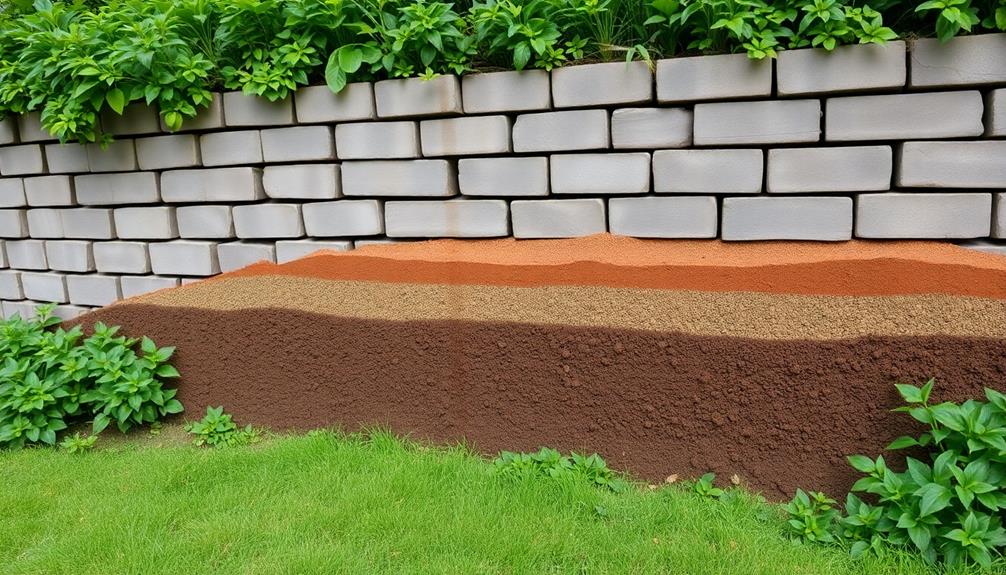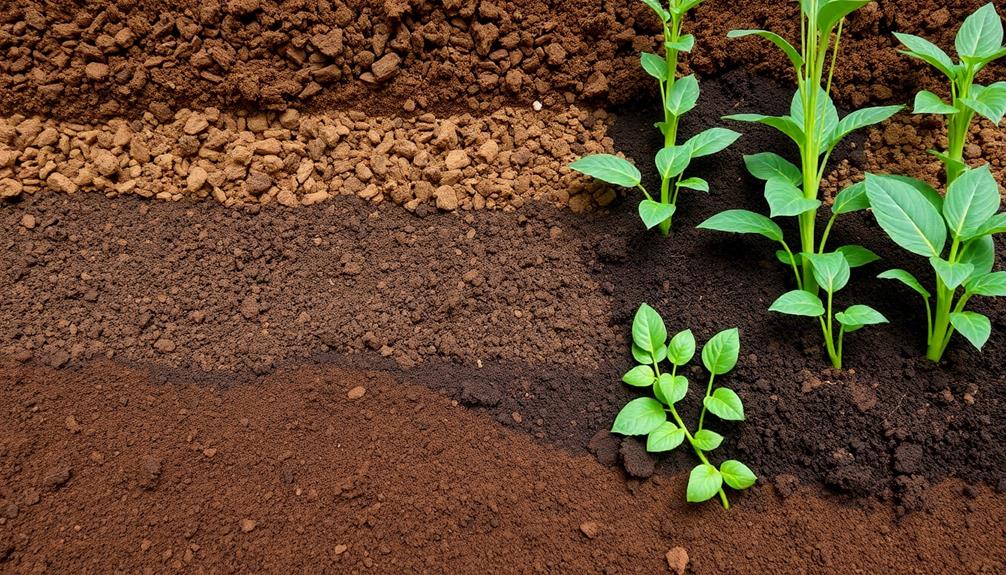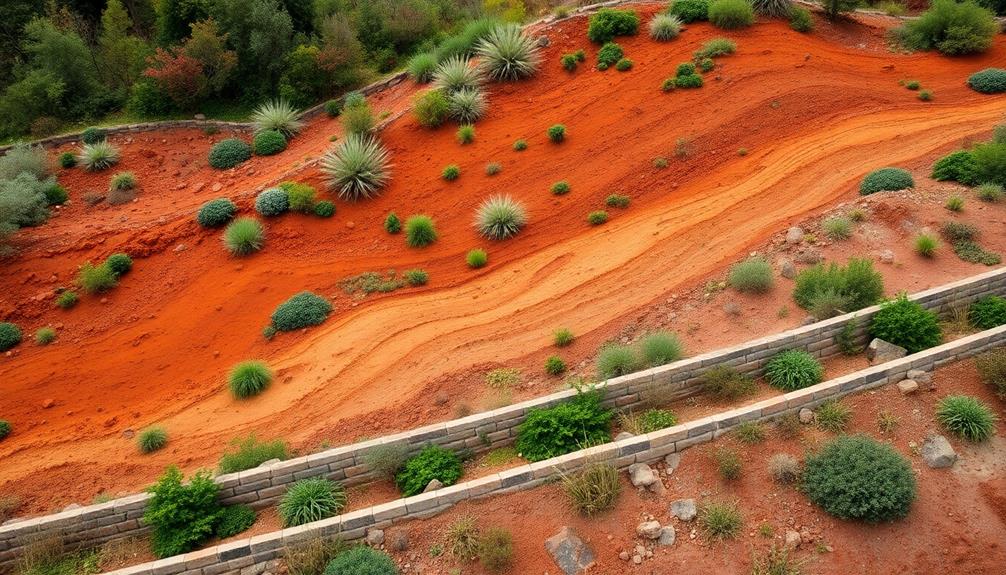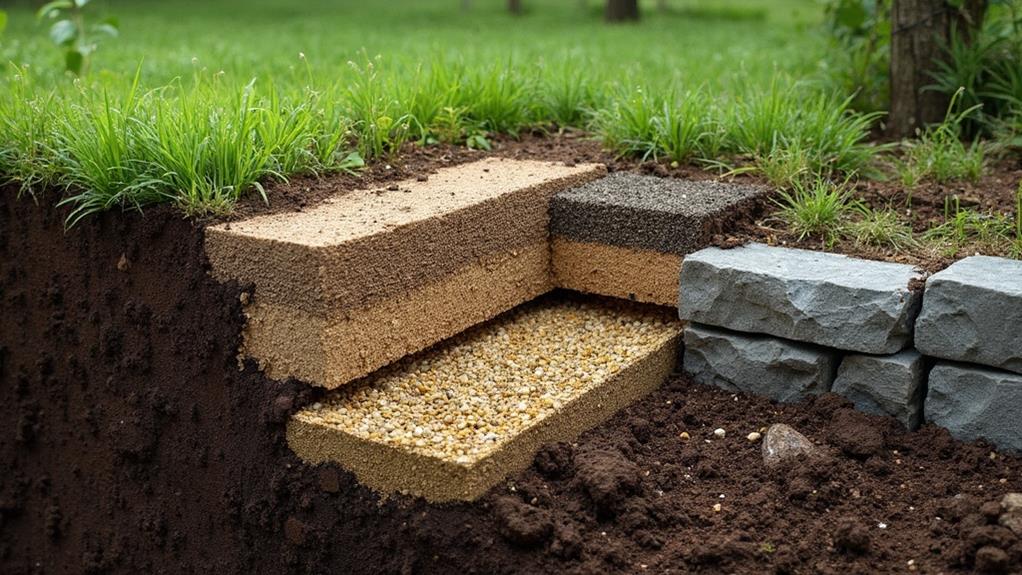Choosing the right soil for your retaining wall is vital for ensuring its stable structure and long-term performance. Focus on selecting granular backfill soils like sand, gravel, or crushed stone, as these offer excellent drainage and compaction while minimizing erosion-related risks. Avoid cohesive soils, such as clay, which retain water and cause hydrostatic pressure, potentially leading to wall failure. Consider the wall's load-bearing needs, factoring in soil's density, friction angle, and compaction capability to support environmental conditions. Evaluating these characteristics helps you select a soil composition that aligns with the retaining wall's structural requirements and climate resilience, enhancing the project's success.
Table of Contents
ToggleWalls Contractor Highlights
- Select granular soils like sand, gravel, or crushed stone for excellent drainage and compaction.
- Avoid clay-rich soils due to their high moisture retention and susceptibility to freeze-thaw cycles.
- Ensure soil is well-compacted to reduce water infiltration and prevent frost heave.
- Choose soils with high shear strength to resist displacement and maintain wall stability.
- Consider local climate patterns to select soil that complements hydrological and temperature needs.
Purpose of Retaining Wall Soil

The soil selected for a retaining wall plays a pivotal role in ensuring the structure's stability, providing adequate drainage to prevent water buildup, and supporting the loads exerted by the retained earth. It's indispensable to contemplate the type of retaining wall materials being used, such as fieldstone or boulder walls, as different materials might influence the soil requirements.
Stability is paramount as the soil must adequately resist erosion and displacement, while also maintaining its integrity under varying weather conditions. A common function of retaining walls is to prevent erosion on the property, making the choice of soil even more critical.
Furthermore, the chosen soil must possess effective draining capabilities to prevent hydrostatic pressure, and it must be able to bear the anticipated loads to avoid structural failure.
Soil Stability Importance
Understanding the critical role of soil stability in the effectiveness of a retaining wall cannot be overstated. Soil stability serves as the backbone for a retaining wall's enduring structural integrity, ensuring that both the wall and the surrounding landscape remain unyielding against the erosion forces. The importance of selecting the right soil type—coupled with the site-specific conditions—cannot be underestimated for achieving ideal stability.
Cohesive soils, encompassing clay and silty variants, although rich in binding properties, can often lead to drainage challenges that impede long-term structural stability. Conversely, non-cohesive soils such as gravel and sand offer excellent permeability, allowing for efficient load transfer and enhanced resistance to rotational and translational movement.
Importantly, soil stability is not an isolated consideration but rather a dynamic component of retaining wall design, where geotechnical evaluations should guide soil selection processes. This confluence of engineering precision and geological insight fosters a sense of synergy, ensuring each wall integrates seamlessly into its environment.
Ultimately, the pursuit of suitable soil stability empowers communities, offering shared spaces that are not only visually appealing but safe, resilient, and enduring. In this communal fabric, details matter—the right soil choices uphold the collective vision for a well-structured, harmonious landscape.
Drainage Capability Needs
Effective drainage capability is indispensable when selecting soil for a retaining wall, defining its long-term functionality and structural health. Retaining walls, by design, hold back soil and manage gravitational and environmental forces, and as a result, the soil's ability to offer sufficient drainage is irreplaceable. The right soil mitigates the risk of water accumulation behind the wall, preventing the hydrostatic pressure that can lead to wall failure over time.
Soil with high drainage capability allows water to percolate efficiently, minimizing saturation and maintaining equilibrium within the retaining system. Granular soils like sand and gravel are often recommended for achieving excellent drainage properties. These materials prevent water entrapment by enabling fluid movement, consequently contributing to the structural integrity of the retaining wall.
Compacted gravel layers, along with strategically designed drainage systems such as weep holes, are beneficial to disperse water build-up effectively. Ensuring appropriate drainage not only enhances the wall's durability but fosters a sense of community among property owners and builders, who stand united in the shared goal of sustainable and enduring landscape solutions. Selecting the proper soil type underscores a commitment to quality and longevity in landscape architecture, resonating with an audience seeking reliability and trust.
Load-Bearing Requirements
A vital aspect of selecting soil for a retaining wall is its load-bearing capability, directly tied to the wall's purpose and the weight it must support. A retaining wall may be required to support sloped terrain, terraces, or structures, each demanding specific soil characteristics to guarantee strength and stability.
Soil composition, texture, and compaction are indispensable factors that influence the load-bearing capacity of a retaining wall system. Certain soils, like clay, may offer high cohesion but poor drainage, potentially leading to instability under load. Conversely, well-graded gravel and sand provide effective load support with enhanced drainage properties.
To address these requirements, understanding the fundamental engineering properties of soils is essential. Cohesive soils are typically avoided or treated to reduce the risk of structural failure, while non-cohesive, granular soils, enhanced through compaction, often become preferred choices.
Engineers and designers must evaluate soil density, internal friction angles, and cohesion to determine suitability for the load a retaining wall must bear. Selecting the correct soil guarantees the wall's durability, lending a sense of security and shared achievement to the collective investment in community infrastructure, effectively fulfilling both utilitarian and protective roles in landscapes subject to diverse challenges.
Benefits

Selecting the appropriate soil for a retaining wall offers multiple advantages that strengthen both functionality and sustainability. By enhancing drainage efficiency, the right soil choice mitigates water accumulation, thereby supporting the wall's structural stability.
Additionally, it promotes plant growth and reduces erosion risks, ensuring a harmonious balance between engineering and ecological considerations. Whether used for limestone wall installation or any other type of construction, the correct soil is key to maintaining durability and enhancing the aesthetic appeal of the landscape.
Enhances Drainage Efficiency
For a successful retaining wall, the choice of soil is critical because it vastly improves drainage efficiency, thereby prolonging the structure's longevity. The appropriate soil selection guarantees that water pressure does not build up behind the wall, which can otherwise cause severe damage over time. Granular soils, such as sandy or gravelly soils, are preferred due to their superior drainage characteristics. These soils allow water to pass through more effortlessly compared to cohesive soils like clay, thereby minimizing hydrostatic pressure and reducing the risk of wall failure.
An effectively draining retaining wall not only protects the structural integrity of the wall itself but also prevents water from pooling around it, which can lead to erosion or flooding of adjacent land. The absence of accumulated water considerably reduces the likelihood of freezing and thawing cycles that might otherwise undermine the foundation. By supporting efficient water evacuation, the right soil choice fosters a robust and enduring landscape, offering peace of mind to those who invest in its construction.
When members within a community come together to build retaining walls with ideal soil and drainage solutions, they create an environment of enduring beauty and resilience, consequently fostering a shared sense of achievement.
Supports Structural Stability
Guaranteeing structural stability in retaining walls begins with the ideal selection of soil, which plays a fundamental role in maintaining the wall's integrity under varying load conditions. The proper choice of soil not only assures durability but also aids in adequately bearing the forces exerted by the retained material and external elements such as water or seismic activities.
Soil types such as granular backfill, comprising sand, gravel, or crushed stone, are preferred for their excellent drainage characteristics and ability to compact tightly, reducing pressure against the wall and preventing erosion that could otherwise compromise structural soundness.
Granular soils exhibit minimal swelling and shrinkage due to their low clay content, greatly reducing differential movement, a leading cause of structural failure. Additionally, these soils provide high shear strength, resisting displacement and keeping the wall firmly in place.
It is pivotal to ponder soil characteristics and local conditions to accomplish optimal stability. Seeking professional guidance during the soil selection process fosters a sense of belonging within a community of informed homeowners and builders, aligned with best practices that uphold the structural integrity of retaining walls amidst environmental challenges. Selecting the right soil is not a mere step but a foundational strategy for enduring construction.
Promotes Plant Growth
In addition to their structural role, the choice of soil for retaining walls greatly influences the success of landscaping efforts by promoting plant growth. The strategic selection of soil not only anchors the wall but also creates a hospitable environment for vegetation, fulfilling both aesthetic and ecological purposes. The right soil mix typically includes a balance of essential nutrients, adequate drainage, and a texture that fosters strong root systems, ensuring that plants are not just surviving, but thriving.
At the heart of this selection process is understanding soil composition. A blend of topsoil, compost, and sand often serves well, combining the ability to retain moisture with effective drainage — preventing waterlogging while providing roots with ample air circulation. This balance is indispensable because it allows plants to access water and nutrients optimally, supporting lush growth and vibrant health.
Furthermore, selecting soil that aligns with the specific plant species near your retaining wall can greatly enhance your landscaping outcomes. Plants, in harmony with their soil environments, create welcoming landscapes where communities can gather and grow. By fostering an ecosystem that celebrates natural growth and resilience, a retaining wall becomes more than a boundary—it transforms into a nurturing part of the landscape.
Reduces Erosion Risks
Erosion is a critical concern when designing and constructing retaining walls, as it can compromise the structural integrity and longevity of the wall. Selecting the appropriate soil for your retaining wall is essential because it directly influences the capacity to mitigate erosion risks.
Properly chosen soil enhances drainage and minimizes water retention, preventing the build-up of hydrostatic pressure behind the wall that can lead to erosion. Granular soils such as sandy or gravelly textures are typically preferred in this context as they facilitate rapid water movement, thus curtailing excess moisture accumulation.
Ensuring the right blend of soil can complement effective drainage systems and reinforce the wall structure, providing a sturdy support system ready to withstand natural forces. Incorporating geotextiles in conjunction with suitable soil can further bolster erosion control by stabilizing the soil layers and reducing the potential for washout, thereby fostering a cohesive environment that meets community expectations for safety and durability.
Thoughtful soil selection contributes not only to the wall's strength but also to the shared mission of preserving land integrity, reflecting the values of stewardship and collective responsibility towards the environment.
Climate Impact on Soil Selection

Understanding the influence of climate on soil selection for retaining walls is vital, as various climatic factors extensively affect the soil's performance and stability. For instance, temperature variations can alter soil properties, affecting its moisture retention capabilities and susceptibility to freeze-thaw cycles, which may lead to structural challenges. Below is a table highlighting these climate-related factors:
| Climate Factor | Impact on Soil Selection |
|---|---|
| Temperature Influence | Alters soil properties and structure |
| Moisture Retention | Varies with climatic conditions |
| Freeze-Thaw Cycles | Can cause expansion and contraction |
Temperature Influence on Soil
Temperature plays an essential role in determining the properties and suitability of soil for retaining wall construction. Select the right soil by understanding how temperature variations affect soil structure and performance. Temperature fluctuations can lead to expansion and contraction in soil materials, which may compromise the integrity of retaining walls. Evaluating regional temperature patterns is therefore pivotal for ensuring longevity and stability.
Frost Heave Effects: In colder climates, freezing temperatures can cause frost heave, raising the soil and impacting the wall's structural soundness. This phenomenon arises when water in the soil freezes, expands, and pushes the soil upward, potentially destabilizing the wall foundation.
Thermal Expansion: There is a risk of thermal expansion in soils subjected to high temperatures. As soil particles expand due to heat, the pressures exerted on retaining walls can increase, which might lead to deformation or structural failure if not accounted for in the design.
Soil Type Sensitivity: Different soils react uniquely to temperature changes. For instance, clayey soils are particularly sensitive to temperature shifts, becoming more plastic in warmer conditions, thus altering their load-bearing capabilities.
Understanding these temperature-related influences ensures informed soil selection and design considerations for retaining wall projects, fostering a sense of inclusion and security within our community-oriented construction efforts.
Moisture Retention Variability
Moisture retention variability is a critical factor in selecting the appropriate soil for retaining walls, as climate greatly impacts a soil's ability to hold water. In regions with heavy rainfall or high humidity, soils with lower water retention capabilities are typically favored to prevent over-saturation, which can compromise structural integrity.
Conversely, in arid climates where water is scarce, soils that possess a higher retention capacity might be chosen to maintain stability and support vegetation.
Understanding the local climate patterns aids in selecting soil that complements the specific hydrological needs of a retaining wall. For instance, clay soils, known for their high moisture retention due to their fine particles, might cause issues like erosion or swelling in wetter climates.
On the other hand, sandy soils offer excellent drainage but may fail to adequately support plants or the wall in drought conditions.
Professionals constructing retaining walls need to analyze both immediate weather conditions and seasonal climatic changes to optimize soil selection. By integrating local climate data, you can achieve not only a durable retaining wall but also foster a sense of harmony with the surrounding environment, ensuring the collaborative success of your landscaping endeavors.
Freeze-Thaw Cycle Effects
Selecting soil for retaining walls also involves considering the impact of freeze-thaw cycles, which can pose significant risks to structural stability. When temperatures fluctuate around the freezing point, water within the soil expands as it freezes, potentially leading to increased pressure on the retaining wall. To minimize these risks, selecting the appropriate soil type is indispensable, as the impact of freeze-thaw cycles varies depending on the soil's properties.
Drainage Capacity: Soils with high drainage capabilities, such as sandy soils, allow water to exit rapidly, reducing the volume of ice that can form and thus minimizing stress on the wall structure. Poorly draining soils, like clays, tend to hold water, exacerbating freeze-thaw damage.
Compaction Level: Highly compacted soils tend to resist water infiltration effectively, thereby lowering the chances of frost heave. Loose soils, lacking in compaction, are more susceptible to water intrusion, which can lead to significant structural shifts during the freeze-thaw process.
Thermal Conductivity: Some soils possess higher thermal conductivity, enabling them to transfer heat more efficiently. This property can reduce the impact of freeze-thaw cycles by minimizing temperature variations within the soil adjacent to the retaining wall, consequently maintaining its overall stability.
For communities facing these climate challenges, informed soil selection ensures lasting structural integrity.
Walls Contractor FAQ
How Does Soil Type Affect Wall Stability and Drainage?
Soil type substantially influences wall stability and drainage by determining the soil's weight, compaction capabilities, and water retention. Opting for the right soil guarantees structural integrity and effective drainage, fostering a secure and harmonious environment for all.
What Are the Maintenance Requirements for Retaining Wall Soil?
Regular maintenance for retaining wall soil involves monitoring for erosion, ensuring proper drainage, and addressing any plant overgrowth. Frequent inspections can fortify wall integrity and foster a cohesive landscaping environment, ensuring long-term support and stability.
Can Different Soil Types Be Mixed for a Retaining Wall?
Yes, different soil types can be combined to optimize stability and drainage in retaining walls. Collaborating with soil specialists guarantees the blend suits local conditions, fostering unity and confidence in sustainable construction practices that benefit communities.
How Do Local Regulations Affect Soil Choice for Retaining Walls?
Local regulations greatly impact soil selection for retaining walls by stipulating safety, stability, and environmental compatibility measures. Compliance guarantees community safety and environmental stewardship, fostering a shared responsibility towards community standards and sustainable land use practices.
Is Specialized Equipment Needed for Compacting Soil in Retaining Walls?
Specialized equipment, such as plate compactors or vibrating rollers, is often necessary to guarantee optimal soil compaction for retaining walls. Proper compaction strengthens the structure, fostering durability and reliability, consequently enhancing safety and community trust in construction practices.







